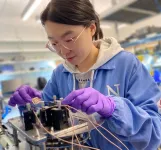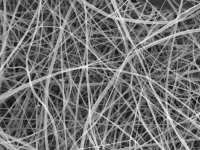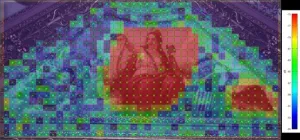Northwestern University scientists have developed a new protective coating that significantly extends the life of perovskite solar cells, making them more practical for applications outside the lab.
Although perovskite solar cells are more efficient and less expensive than traditional silicon solar cells, perovskite has, until now, been limited by its lack of long-term stability. Typically, perovskite solar cells uses an ammonium-based coating layer to enhance efficiency. While effective, ammonium-based layers degrade under environmental stress, such as heat and moisure.
Northwestern researchers have now developed a more robust layer — based on amidinium.
In experiments, the new coating was 10 times more resistant to decomposition compared to conventional ammonium-based coatings. Even better: the amidinium-coated cells also tripled the cell’s T90 lifetime — the time it takes for a cell’s efficiency to drop 90% of its initial value when exposed to harsh conditions.
The research will be published on Friday (Nov. 22) in the journal Science.
“The field has been working on the stability of perovskite solar cells for a long time,” said Northwestern’s Bin Chen, who co-led the study. “So far, most reports focus on improving the stability of the perovskite material itself, overlooking the protective layers. By improving the protective layer, we were able to enhance the solar cells’ overall performance.”
“This work addresses one of the critical barriers to widespread adoption of perovskite solar cells — stability under real-world conditions,” said Northwestern’s Mercouri Kanatzidis, who co-led the study. “By chemically reinforcing the protective layers, we’ve significantly advanced the durability of these cells without compromising their exceptional efficiency, bringing us closer to a practical, low-cost alternative to silicon-based photovoltaics.”
Chen is a research associate professor of chemistry at Northwestern’s Weinberg College of Arts and Sciences. He co-led the study with Ted Sargent, the Lynn Hopton Davis and Greg Davis Professor Chemistry at Weinberg and professor of electrical and computer engineering at the McCormick School of Engineering, and Kanatzidis, the Charles E. and Emma H. Morrison Professor of Chemistry at Weinberg. Yi Yang, a postdoctoral fellow co-advised by Sargent and Kanatzidis, is the paper’s first author.
Perovskite as an alternative to silicon
In use for decades, silicon is the most commonly used material for the light-absorbing layer in solar cells. While silicon is durable and reliable, it's expensive to produce and is approaching its ceiling of efficiency. In search of a lower cost and higher efficiency solar cell, researchers recently began exploring perovskites, a family of crystalline compounds.
Although it demonstrates promise as a cost-effective alternative to silicon, perovskite has a relatively short lifespan. Prolonged exposure to sunlight, extreme temperature fluctuations, moisture and humidity all cause perovskite solar cells to degrade over time.
To overcome this challenge, the researchers added amidinium ligands, stable molecules that can interact with perovskite to provide long-lasting defect passivation and protective effects. Ammonium-based molecules have a nitrogen atom surrounded by three hydrogen atoms and one carbon-containing group, while amidinium-based molecules comprise a central carbon atom bonded to two amino groups. Because their structure allows electrons to spread out evenly, amidinium molecules are more resilient under harsh conditions.
“State-of-the-art perovskite solar cells typically have ammonium ligands as a passivation layer,” Yang said. “But ammonium tends to break down under thermal stress. We did some chemistry to convert the unstable ammonium into a more stable amidinium.”
The researchers performed this conversion through a process known as amidination, in which the ammonium group is replaced with a more stable amidinium group. This innovation prevented the perovskite cells from breaking down over time — especially when exposed to extreme heat.
Record-breaking results
The resulting solar cell achieved an impressive 26.3% efficiency, which means it successfully converted 26.3% of absorbed sunlight into electricity. The coated solar cell also retained 90% of its initial efficiency after 1,100 hours of testing under harsh conditions, demonstrating a T90 lifetime three times longer than before when exposed to heat and light.
These experiments mark the latest example of improved perovskite solar cell performance from the Sargent lab. In 2022, Sargent’s team developed a perovskite solar cell that broke records for energy efficiency and voltage. In 2023, his team introduced a perovskite solar cell with an inverted structure, which also improved its energy efficiency. And earlier this year, Sargent’s group incorporated liquid crystals to minimize the defects in perovskite films, leading to enhanced device performance.
“Perovskite-based solar cells have the potential to contribute to the decarbonization of the electricity supply once we finalize their design, achieve the union of performance and durability, and scale the devices,” said Sargent, who directs the Paula M. Trienens Institute for Sustainability and Energy. “The primary barrier to the commercialization of perovskite solar cells is their long-term stability. But due to its multi-decade head start, silicon still has an advantage in some areas, including stability. We are working to close that gap.”
This research is directly tied to the Generate pillar — one of the Trienens Institute Six Pillars of Decarbonization. As a part of the Generate pillar, Northwestern commits to build a new class of solar energy production by focusing on high-efficiency multi-junction solar cells and next-generation solar cell materials. Kanatzidis is a faculty co-chair of the pillar, and Chen is the implementation lead.
The study, “Amidination of ligands for chemical and field-effect passivation stabilizes perovskite solar cells,” was supported by First Solar, the Department of Commerce, the National Institute of Standards and Technology and the U.S. Department of Energy.
END





